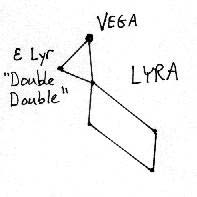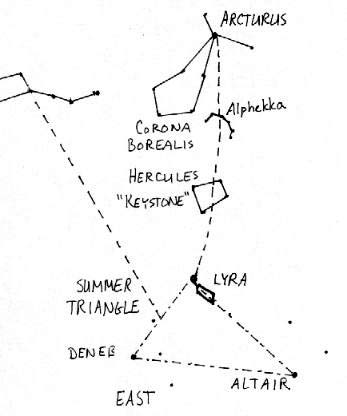
Early on a summer evening, the brightest star visible directly east is Vega, in the constellation Lyra, the Lyre. Lyra (LYE-rah) is small and not bright, but should be visible from moderately dark backyards. Vega is part of a triangle that is perched on the corner of a rhomboid parallelogram.
The other triangle star that is not touching the parallelogram is Epsilon Lyrae, the "double double" star. With binoculars, you will see there are two 5th magnitude stars. A small telescope reveals that each of those stars is also a double star.

Vega is also part of another geometric sky grouping, the large asterism known as the Summer Triangle. As it rises, Vega is at the peak of the triangle. The two bright stars forming the base are Deneb on the left and Altair on the right. To confirm that you are looking at the right stars, use the handle side of the Big Dipper's cup as a pointer. Pointing from bottom to top, go 60 degrees (two hand spans plus a fist-width) and you will end up between Vega and Deneb on the short side of the triangle. As for Altair - it's the one that makes the other two look like a triangle instead of a stick.
Once you have found Vega, look for Arcturus high overhead. Remember to "follow the Arc (of the Big Dipper's handle) to Arcturus if you aren't sure where it is. Now imagine a line between the two stars. This line passes through two constellations. On the Arcturus side, near the shoulder of Bootes and along the arc, is Corona Borealis, the Northern Crown. The crown is a half-circle of stars. In fact, the common name for the bright central star is Alphekka, which means "broken ring." The legend is that Dionysus threw the crown of a princess, Ariadne, into the air to prove he was a god and win her hand in marriage.

Closer to the midpoint of the line is the famous hero, Hercules. While his strength was legendary, this constellation is rather dim. What's more, no two star maps draw it exactly alike, but almost all of them agree that the big lug's body is the four-star trapezoidal asterism commonly called the Keystone. It's the kind of body you would expect on a strongman - wide at the shoulder, narrow at the hip. The Vega-Arcturus line runs through the two longer sides of the Keystone.
The Hercules Cluster (M13) is on the long side of the Keystone that is closer to Arcturus and Alphekka. You may see a faint fuzzy spot with your naked eye, just below the right shoulder star. With binoculars, you will see a larger, brighter spot. A medium size telescope will resolve the outer stars of this globular cluster into individual stars.
Another globular cluster, M92, is roughly where Hercules head would be, above the two shoulder stars. It is not quite as large or bright as M13, but it still shows up in binoculars as a compact hazy spot.

The Piker Press moderates all comments.
Click here for the commenting policy.